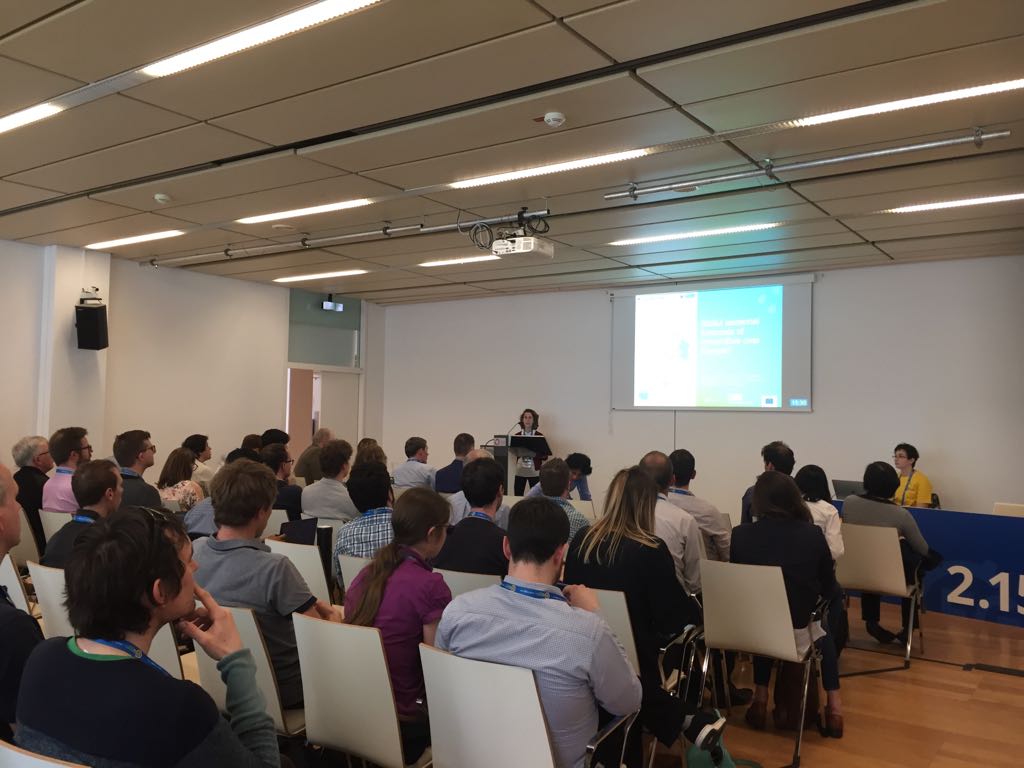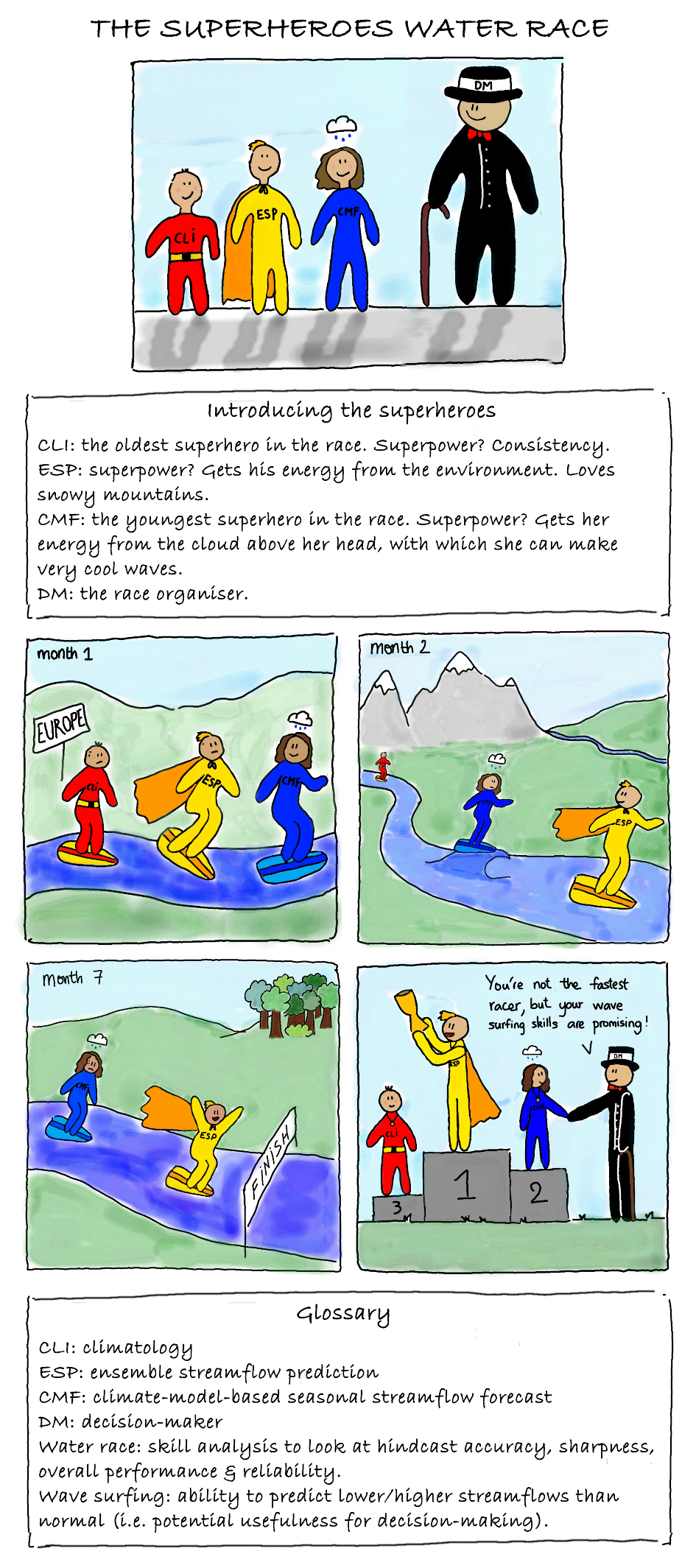Skilful seasonal forecasts of streamflow over Europe?
Contributed by Louise Arnal, University of Reading & ECMWF
Editor’s Note: Don’t miss the brilliant cartoon summary at the bottom of this post!
Over recent decades, seasonal streamflow forecasting methods have evolved and diversified, reflecting changes in our scientific understanding of streamflow predictability on seasonal timescales and our increasing computer power. The first operational model-based ensemble seasonal streamflow forecast, called the ESP1,2 (ensemble streamflow prediction), relies on the correct knowledge of the initial hydrological conditions (IHC; i.e. of snowpack, soil moisture, streamflow and reservoir levels, etc.) and a large land surface memory, and contains no information on the future climate (if you’d like to know more about the ESP, I recommend reading this very good HEPEX blog post about it!).
In basins where the meteorological forcings drive the streamflow predictability however, this last point is a limitation of the ESP. This motivates the use of seasonal climate forecasts to feed hydrological models and extend the predictability of hydrological variables on seasonal timescales3, which we refer to as climate-model-based seasonal streamflow forecasts (CM-SSF). While studies exploring the skill of CM-SSF are abundant outside of Europe, they are still relatively scarce in this part of the world, partly due to the limited quality of seasonal climate forecasts (particularly for the variables of interest to hydrology: precipitation and temperature) for the extra-tropics.
In our recent paper, published in the HESS special issue on Sub-seasonal to seasonal hydrological forecasting, we carried out a Europe-wide analysis of the skill of the newly operational EFAS (European Flood Awareness System) CM-SSF (produced using the raw ECMWF System 4 seasonal climate forecast [Sys4] as an input to the Lisflood hydrological model), benchmarked against the ESP (produced using historical meteorological observations as an input to Lisflood; both forecasts go out to 7 months lead time). Below are the two main questions tackled in this paper.

Louise presenting results from this paper at EGU 2018.
Does seasonal climate information improve the predictability of seasonal streamflow over Europe?
Overall, we found that Sys4 improves the predictability over historical meteorological information for pan-European seasonal streamflow forecasting for the first month of lead time only (in terms of accuracy, sharpness and overall performance). This shows the importance of the IHC and the land surface memory for seasonal streamflow forecasting in Europe. However, the predictability varies per season and we show that the CM-SSF is more skilful at predicting autumn and winter streamflows than for the spring and summer.
Our findings suggest that patterns in the CM-SSF skill are not mirrored in the Sys4 precipitation and temperature hindcasts, which calls for a more in depth look into the link between meteorological and hydrological variables on seasonal timescales over Europe.
What is the potential usefulness of the EFAS seasonal streamflow forecasts for flood preparedness?
As the quality of seasonal streamflow forecasts increases, their usability for decision-making has lagged behind. Translating forecast quality into added value for decision-making is not straightforward for short-range forecasting, let alone on seasonal timescales. While this has been explored for many water-related applications, such as navigation4, reservoir management5, water resource management6 and hydropower7, among others, seasonal streamflow forecasts have yet to be adopted by the flood preparedness community. In this paper, we additionally investigated the ability of the CM-SSF and the ESP to predict lower and higher than normal streamflow conditions up to 7 months ahead, which we term potential usefulness.
Here, we show results for higher than normal streamflows only (see the figure below); results for lower than normal streamflows can be found in the paper. Overall, we found that at least one of the two forecasting systems is capable of predicting higher than normal streamflows months in advance, with the ESP the most potentially useful system generally. However, our results suggest that the CM-SSF is more potentially useful than the ESP beyond 1 month of lead time for certain European regions and seasons, noticeably in winter for ~40 % of Europe.
Following the Red Cross Red Crescent Climate Centre Ready-Set-Go! approach8, seasonal streamflow forecasts could complement existing forecasts at shorter timescales and provide monitoring and early-warning information for flood preparedness.

Maps of the most potentially useful forecasting system (based on its ability to predict higher than normal streamflows, as measured with the ROC score) for all four seasons. The pie charts (also known as camembert plots in France!) display the ‘best’ system for each lead time (i.e. 1 to 7 months), as shown in the example pie chart. There are three possible cases: (1) neither the ESP nor the CM-SSF is potentially useful (red), (2) the ESP is potentially useful and better than the CM-SSF (yellow), or (3) the CM-SSF is potentially useful and better than the ESP (blue).
If you’d like to know more about this research, you can read the full paper here.
And if you’ve always wondered what a paper would be like if it was written as a cartoon with superheroes, check out the cartoon I made to summarise this paper!

References:
1Twedt, T. M., Schaake, J. C., and Peck, E. L.: National Weather Service extended streamflow prediction, Proceedings Western Snow Conference, Albuquerque, New Mexico, 52–57, April 1977.
2Day, G. N.: Extended streamflow forecasting using NWSRFS, J. Water Res. Plan. Man., 111, 157–170, https://doi.org/10.1061/(ASCE)0733-9496(1985)111:2(157), 1985.
3Pagano, T. C. and Garen, D. C.: Integration of climate information and forecasts into western US water supply forecasts, Climate variations, climate change, and water resources engineering, edited by: Garbrecht, J. D. and Piechota, T. C., American Society of Civil Engineers location, Reston, Virginia, US, 86– 103, 2006.
4Meißner, D., Klein, B., and Ionita, M.: Development of a monthly to seasonal forecast framework tailored to inland waterway transport in central Europe, Hydrol. Earth Syst. Sci., 21, 6401–6423, https://doi.org/10.5194/hess-21-6401-2017, 2017.
5Turner, S. W. D., Bennett, J. C., Robertson, D. E., and Galelli, S.: Complex relationship between seasonal streamflow forecast skill and value in reservoir operations, Hydrol. Earth Syst. Sci., 21, 4841–4859, https://doi.org/10.5194/hess-21-4841-2017, 2017.
6Schepen, A., Zhao, T., Wang, Q. J., Zhou, S., and Feikema, P.: Optimising seasonal streamflow forecast lead time for operational decision making in Australia, Hydrol. Earth Syst. Sci., 20, 4117– 4128, https://doi.org/10.5194/hess-20-4117-2016, 2016.
7Hamlet, A. F., Huppert, D., and Lettenmaier, D. P.: Economic Value of Long-Lead Streamflow Forecasts for Columbia River Hydropower, J. Water Res. Plan. Man., 128, 91–101, https://doi.org/10.1061/(ASCE)0733-9496(2002)128:2(91), 2002.
8White, C. J. et al.: Potential applications of subseasonal-to-seasonal (S2S) predictions, Meteorol. Appl., 24, 315–325, https://doi.org/10.1002/met.1654, 2017.
0 comments